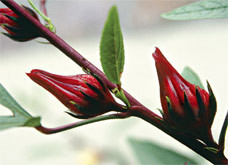 Hibiscus Chinese roseChinese rose,undoubtedly one of the most popular species of hibiscus, but far from the only one. The genus is unusually rich - it has more than 250 species. Among them are evergreen and deciduous trees and shrubs, perennial and annual herbs, and not all of them have large, bright flowers. These plants, belonging to the mallow family, are mainly common in Southeast Asia, but some species are native to Africa and America. In America, for example, hibiscus, which is called "swamp mallow" for its love of moisture, forms entire thickets in damp meadows. In Hawaii, hibiscus is considered a national plant, and its buds are a symbol of "beautiful women". And in Egypt, the flowers of the species growing there have always been valued for their healing properties.
Hibiscus Chinese roseChinese rose,undoubtedly one of the most popular species of hibiscus, but far from the only one. The genus is unusually rich - it has more than 250 species. Among them are evergreen and deciduous trees and shrubs, perennial and annual herbs, and not all of them have large, bright flowers. These plants, belonging to the mallow family, are mainly common in Southeast Asia, but some species are native to Africa and America. In America, for example, hibiscus, which is called "swamp mallow" for its love of moisture, forms entire thickets in damp meadows. In Hawaii, hibiscus is considered a national plant, and its buds are a symbol of "beautiful women". And in Egypt, the flowers of the species growing there have always been valued for their healing properties.
Chinese rose (Hibiscus rosa-sinensis)
It is native to Southeast Asia.In their native land, they are quite large shrubs, up to 2-4 m high, with large oblong dark green leaves and simple scarlet flowers. In Mediterranean countries, they are grown in gardens and parks in open ground. And those compact and low-growing hibiscuses that are sold as indoor plants are usually regularly treated with substances that inhibit growth and enhance branching. After the expiration of these substances, the plant can return to its natural habits and grow faster. Advice When buying a Chinese rose, choose a well-developed bushy plant, but without buds. If the conditions change (in a greenhouse they are always different than in an apartment), the Chinese rose will shed its buds. Varieties differ primarily in doubleness, color and size of flowers. There are varieties with oblong or heart-shaped, slightly wavy leaves, bright green or dark with a purple tint. Variegated hibiscus has graceful leaves on long petioles with white, creamy and pinkish stripes, strokes and borders. The flower can be white, dark red, orange or orange-yellow, salmon, apricot or cream. The edges of the petals are smooth or wavy. The fused stamen filaments form a tube that contains the pistil column. The entire structure resembles a plume or a brush and protrudes far beyond the edge of the flower. Non-double varieties have a bright or dark spot in the throat of the flower and five wide petals overlapping each other. In double varieties, the petals located closer to the center are narrow, as if slightly incised, the diameter of the flower is 10-15 cm. The latest achievement of American selection is varieties with flowers about 25 cm in diameter (like plates of different colors!) have displaced the recently popular terry varieties. By the way,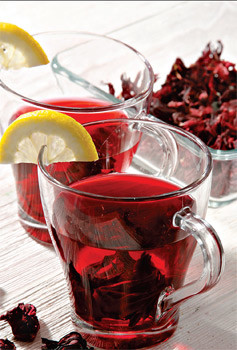 Hibiscus Sudanese Rose (Hibiscus sabdariffa)cultivated in tropical regions of Africa and Asia. Another name for this species is hibiscus. Many associate it with a drink of rich ruby color, sour taste and excellent thirst quencher. To prepare it, they use the fleshy sepals of the plant (not petals, not fruits and not shoots, as you can sometimes read on the packaging), and the red decoction is used to color jellies and desserts.
Hibiscus Sudanese Rose (Hibiscus sabdariffa)cultivated in tropical regions of Africa and Asia. Another name for this species is hibiscus. Many associate it with a drink of rich ruby color, sour taste and excellent thirst quencher. To prepare it, they use the fleshy sepals of the plant (not petals, not fruits and not shoots, as you can sometimes read on the packaging), and the red decoction is used to color jellies and desserts.
Care and reproduction
HibiscusHibiscus
- Lighting - light
- Watering – abundant in summer, moderate during the dormant period
- Soil - breathable, drainage
- Pests and Diseases - Whitefly
The Chinese rose requires space, light and warmth.At air temperatures below 10 °C and above 30 °C in a dry, poorly lit room, hibiscus often sheds its buds. A certain soil moisture is also required - the root ball must not dry out and the water in the pot must not stagnate. In summer, the plant is watered abundantly and sprayed with water - this helps protect it from thrips. Once a month, feed it with mineral fertilizers (15-20 g per 10 l of water). It is good if it is possible to take the plant outdoors - to the garden or to the loggia. Plants are replanted in the spring, replacing the soil. Chinese rose loves an air-permeable, nutritious substrate. It can be composed of turf and leaf soil and humus in a ratio of 2:1:1. During the summer, hibiscus grows by 20 cm or more. If you do not want the crown to grow too much, do not increase the volume of the pot when replanting. In the fall, the shoots of a strongly elongated plant that has lost its decorative effect or has grown too much are shortened by about a third (no more!). Pruning can be postponed until the end of February, in which case the shoots are cut to half their length. In winter, hibiscus requires light and coolness (10-15 ° C). But modern varieties can do without a dormant period and overwinter in an apartment, just away from heaters. It is advisable to spray them periodically. Under favorable conditions, the Chinese rose blooms from April to November, it is especially good in August. Non-double varieties begin to bloom a month earlier than double ones, forming flowers already in the axils of the lower leaves. * Callus (callus) is a tissue that forms on the surface of a wound in plants (in cracks, cuts, at the base of cuttings, in places where the rootstock and scion grow together during grafting) and promotes wound healing. Chinese roses are propagated by green cuttings from June to September. Mature young shoots are taken for cuttings. Buds are removed so that the flowers do not take away the nutrition necessary for root formation. Callus* begins to form on the 7th day under favorable conditions. Cuttings take root within 1.5-2 months. The main shoot must be pinched, otherwise a long whip will grow that will not want to bush out of its own free will.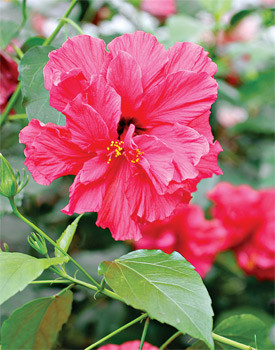
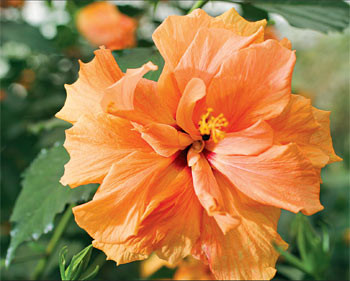
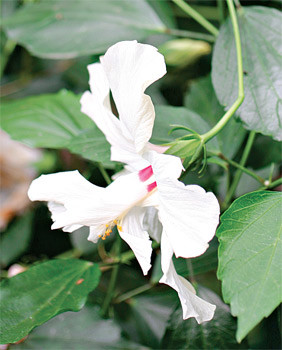
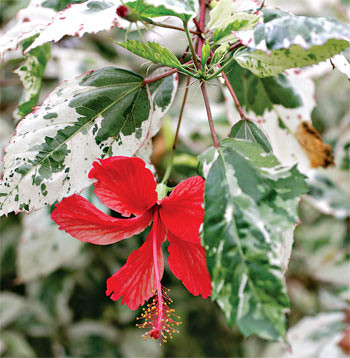
Hibiscus dissected-petal (Hibiscus schizopetalus)
This is a species of "unclear origin".Among the parents are East African hibiscus and Chinese rose. The plants grow more in width, the shoots are horizontal. The flowers are small, on long, thin peduncles. The petals are scarlet, similar to ostrich feathers, bent upwards. It blooms all summer, delighting lovers with exotic flowers. Unlike the Chinese rose, it prefers a shaded place and a temperature of about 20 ° C. It requires a constant level of air humidity. The soil should also be moist, but not wet. If the lump dries out, the buds will crumble. In addition, pests will attack the weakened, dried out plant. If the plant is placed in a bright place for the winter, it can bloom in January.
Syrian hibiscus (Hibiscus syriacus)
It is a deciduous shrub from Asia Minor.In nature, the plant reaches three meters in height and width. The flowers, 6-10 cm in size, are very similar to mallow flowers - silky, often with a dark spot at the base of the petals, with a white, mealy-looking "spadix" in the middle. This plant is surprisingly frost-resistant - it tolerates frosts down to 29 ° C (it needs shelter, like grapes or clematis). But our northern summer is not suitable for it: there is not enough heat for flowering. In Western Europe and in Russian regions with a warm climate, for example on the Black Sea coast, hibiscus syriacus blooms well outdoors from mid-July until frost. The plant tolerates pruning well, and then quickly grows back. Flowers develop on shoots of the current year, but without regular pruning they become smaller. There are varieties with white, pink, lilac, purple flowers, simple and double. There are also variegated ones, for example, "Meehanii" with a golden pattern. When the day becomes shorter and the temperature lower, double varieties can "play a joke" and become non-double. Do not be upset. There will be enough light - and the doubleness will be restored. From a non-double, vigorous variety, you can grow a "tree", that is, a standard form. To do this, at a height of 70 cm, you need to pinch the top, remove the shoots growing from the lower buds, and form a crown from the upper shoots by pinching. In central Russia, this species is grown as a houseplant. In the summer, it is placed on the balcony or taken out to a sunny part of the garden protected from the wind. In winter, they are kept in low light in a cool room at a temperature of 5–10 °C, watered moderately. The dormant period lasts 2–3 months. The seeds formed in the fall can be sown, they germinate well. Since the formation of seeds usually has a bad effect on flowering, triploid sterile hybrids have been bred that only bloom, but do not bear fruit. Moreover, their flowering is much more abundant than that of diploid ones.  Varieties of Hibiscus syriacus with simple flowers
- Blue Bird – blue
- Red Heart – white with a dark red throat
- Hamabo – pinkish-white with dark red speckles
- Rubis – dark pink
- Woodbridge – dark pink, large
Triploids
- Diana – pure white
- Aphrodite – pink
- Minerva – lavender
- Varieties with double flowers
- Boule de Feu – dark red
- Violet Clair Double – lilac
Varieties with double flowers
- Hibiscus syriacus var. caeruleus plenus – light purple
- Hibiscus syriacus var. monstrosus – white with red
- Hibiscus syriacus var. punoceus plenus – red
Photo: Dmitry Korolko, Oleg Kulagin









